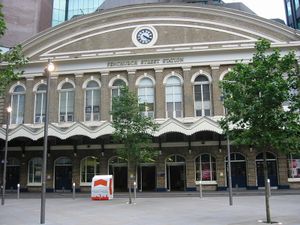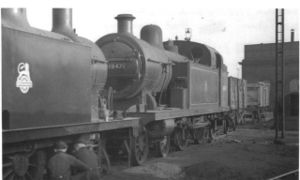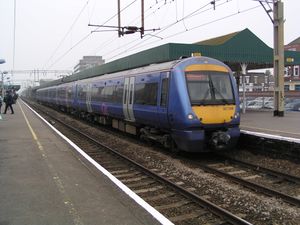London, Tilbury and Southend Railway
| Thameside |
| Principal stations
Fenchurch Street |
The London, Tilbury and Southend Railway (LT&SR) is a railway line linking Fenchurch Street railway station in the City of London with East London and the entire length of the northern Thames Gateway area. It is known as the Thameside Route by Network Rail. [1]
The name also refers to the British railway company which originally built the line in 1854, which was a joint venture between the London and Blackwall Railway and the Eastern Counties Railway.
Train services on the line are currently operated by c2c. The main route from Fenchurch Street to Shoeburyness via Basildon is 40 miles (64 km). The fastest journey time from Fenchurch Street to Shoeburyness is one hour.
Contents
Route
Construction
The LT&SR initially linked London's Fenchurch Street and Bishopsgate stations with Tilbury via Stratford, Barking and Grays. By 1856 the line had been extended to Southend. In 1858 a more direct route from Fenchurch Street to Barking via Plaistow and East Ham was opened and service from Bishopsgate was withdrawn. The line was extended to Shoeburyness in 1884. Between 1885 and 1888 a new shorter route between Barking and Pitsea via Upminster was constructed and between 1892 and 1893 a single line branch was constructed from Romford to Grays via Upminster.
History
In 1912 the railway was bought by the Midland Railway (MR) from under the noses of the nearby Great Eastern Railway (GER). The line was known for its use of 4-4-2 tank engines which were later displaced by 2-6-4Ts after it had been absorbed into the London, Midland and Scottish Railway (LMS) in 1923.
The LMS constructed by 1932, and then managed, the line and stations of what is now a section of the London Underground from Barking to Upminster with services operated by the District Line from the outset; the LMS already managed all stations from Stepney Green to Barking inclusive. The LMS in turn was nationalised in 1948 into British Railways (BR) and in 1949 the line was transferred to the Eastern Region. In 1958 an accident at Dagenham East caused the loss of 10 lives.
The line was electrified at 25 kV AC, using overhead wires in 1962 and passenger service was withdrawn from Bromley, Plaistow, Upton Park, East Ham, Becontree, Dagenham and Hornchurch so trains could run fast from Fenchurch Street to Upminster calling only at Stepney East and Barking. The stopping service of the London Underground District Line remained to serve intermediate stations. At the same time the Romford to Upminster section became physically disconnected from the rest of the line and the separation of the District Line and LTSR services was complete, although tickets continue to be fully interchangeable.
In 1974 a station was opened to serve the new town of Basildon and in 1986 the route was transferred to the Network SouthEast sector of British Rail. During this time the line began to suffer from crumbling infrastructure and limited investment despite its intensive passenger operations. The press picked up on this and it become widely known as the "misery line".
On privatisation, Prism Rail took over operations and marketed the route as LTS Rail. When Prism were bought out by National Express Group the line was rebranded as c2c and the route was given the investment needed to replace rolling stock with new Class 357 Electrostar units and upgrade the infrastructure of the route. In 1995 a station was built at Chafford Hundred to serve the new community there and Lakeside Shopping Centre and in 1999 platforms were constructed at West Ham to provide interchange with the Jubilee Line Extension.
Modernisation
During the early 1990s proposals were put forward to convert the whole line into a guided busway, however these plans were quickly dismissed when British Rail announced a complete re-signalling of the line. Over the years the LTS had been used in an almost experimental fashion and contained a whole host of different signalling systems (e.g. geographical, WESTPAC and relay interlockings). In 1995 work got underway to replace everything from signals, point machines to whole junctions.
The main contractor for the work was GEC Alsthom who provided a Mark 3 solid state interlocking (SSI) system with SEMA providing the IECC element. Main line running signals all became 4 aspect colour (replacing searchlight signals amongst others), all point machines were replaced with HW2000 machines and the whole line had a complete fibre optic network installed. All level crossings were renewed with full barriers to be CCTV controlled by a designated workstation at Upminster.
The main line between Fenchurch Street and Shoeburyness was also bi-directionally signalled (with 3 aspect signalling) along most parts, with the bi-directional section alternating from one track to the other between certain stations, to provide maximum flexibility for continuing operations should disruption occur.
The line was re-born over the Easter weekend 1996 when all the signal boxes from Fenchurch Street to Shoeburyness were switched out and control was transferred to Upminster IECC. This was later followed over the 1996 August bank holiday when Upminster took control from the remaining 'boxes on the Tilbury Loop.
Ownership and management
| Year | Ownership | Management |
|---|---|---|
| Pre-grouping and grouping | ||
| 1854 | Eastern Counties Railway, London and Blackwall Railway | |
| 1912 | Midland Railway | |
| 1923 | London, Midland and Scottish Railway | |
| Nationalisation | ||
| 1948 | British Rail | |
| 1949 | Eastern Region | |
| 1986 | Network SouthEast | |
| Privatisation | ||
| 1996 | Railtrack | LTS Rail (Prism Rail) |
| 2000 | LTS Rail (National Express) | |
| 2002 | Network Rail | c2c (National Express) |
Boat trains
Historically, boat trains operated between St Pancras railway station and Tilbury Riverside railway station. These services reduced as Tilbury declined as a passenger terminal and Tilbury Riverside station finally closed in 1993. A ferry service to Gravesend continues to operate with train services from Fenchurch Street railway station and a bus service from Tilbury Town railway station timed to connect.
Diversion
Trains can be diverted at Barking to call at Stratford and Liverpool Street. Two late weekday evening services in each direction use this route and it is often used at other times because of engineering work or other problems. Trains diverted at Barking, having passed Stratford, can also rejoin the mainline before Limehouse (avoiding West Ham) and continue to Fenchurch Street. This diversionary route is less often used and consists of a short section of single track.
Preservation
Of the original LTS, 4-4-2T number 80 survives at Bressingham Steam Museum in Norfolk. An ex-LT&S BR Std (80079) is preserved on the Severn Valley Railway in Shropshire.
References
- ↑ Network Rail - Route 6 North London Line and Thameside Business Plan (2006)



